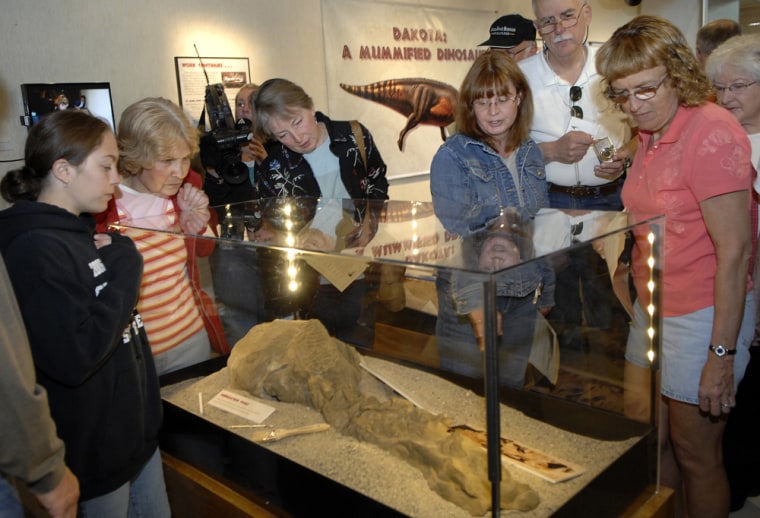Parts of a rare mummified dinosaur that has attracted worldwide interest went on display in North Dakota's state museum.
People from across the country and even England gathered Saturday at the Heritage Center on the state Capitol grounds for the unveiling.
"It is a fascinating fossil, and it's one which we're going to be disinterring secrets from ... for many years to come," said Phillip Manning, a paleontologist at Manchester University in England and a member of the international team of more than 50 researchers working on the project.
In a back room of the museum, a much larger chunk of the prehistoric relic waits for workers with tiny brushes and chisels to free it from its rock tomb — if they can find the money to do it.
The Edmontosaurus named Dakota, a duckbilled dinosaur covered by fossilized skin, lay beneath the western North Dakota soil for about 67 million years before being unearthed between 2004 and 2006. It is among just a few mummified dinosaurs in the world, and researchers working on it say it might be the best in terms of quality and quantity of preserved skin.
Animal tissue typically decomposes quickly after death and most dinosaur fossils are only bone. Researchers say Dakota must have been buried rapidly and in just the right environment for its skin and soft tissues to be replaced by minerals and preserved.
"When you see the final product of the science, it will be something which will be founded in fact and not in just animation and many of the things you see on the television," Manning said.
An arm and tail that workers chipped out of sandstone casing were unveiled at the Heritage Center on Saturday.
"It's certainly drawing a lot of attention to North Dakota," state paleontologist John Hoganson, with the North Dakota Geological Survey, said in an interview. "We know people are going to be coming in from all over the country and world to see this."
Hoganson said he has had calls from interested people from England to Australia.
Most of the Edmontosaurus skeleton remains in what researchers refer to as the "body block." The block was examined earlier in the world's largest CT scanner, operated by the Boeing Co. in California and used to examine space shuttle parts. Researchers still are not yet sure what all it contains, including whether it contains the dinosaur's head.
"It was such a huge file, it hasn't been totally analyzed," Hoganson said. "Everybody feels it's a pretty complete skeleton." Still, a head is "a pretty big question mark," he said.
"It is hard to say how much more money is needed to finish the preparation, but it is likely around $100,000," said Tyler Lyson, a doctoral paleontology student at Yale University who discovered the dinosaur on his uncle's ranch in the North Dakota Badlands in 1999.
The National Geographic Society, which has funded most of the research so far, spending about $200,000, is considering more funding, said spokeswoman Barbara Moffet. "You can safely say it has been one of National Geographic's most significant scientific research investments in recent years," she said in an interview.
Moffet told the crowd at the Heritage Center that National Geographic has funded more than 9,000 research projects. "We've seen a lot of dinosaurs come and go, but we've got to say ... Dakota is like none we've ever seen before," she said.
Hoganson estimated that enough money remains for about three more months of work. He said the hope is to get more funding from National Geographic, but that if no new money is found, he may look for volunteers to work on the mummy.
Stephen Begin, a Michigan consultant on the project who helped meticulously remove the arm and tail from their rock casing, said he thinks it will take "substantially more" money to complete the project than initially thought, though he did not venture a guess as to how much.
He said work on removing the rock around Dakota's body will take at least a year and maybe longer.
"As they get into the body block, there is less skin exposed and places where it's not exposed," he said in a telephone interview. "You don't know if there's skin there or not, so you have to go slow on the assumption there might be.
"You'd rather be safe than, 'oops, I didn't think there would be skin there but there was and I just whacked off a whole bunch,'" said Begin, who estimated he has invested 1,000 hours in the Dakota project.
Lyson's uncle has donated the Dakota fossil to the research foundation started by his nephew, who hopes to eventually send the relic on a worldwide tour and then bring it back to his hometown of Marmarth, in North Dakota's southwestern corner, where he is creating a museum. Lyson said the first stop on the world tour is likely to be Japan, sometime next year.
